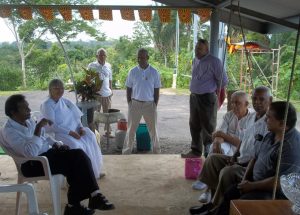
THE experience of the Covid-19 pandemic has been varied in each country.
Trinidad and Tobago has been able to maintain a relatively low number of cases to not overwhelm its healthcare capacity.
This is because we were able to effectively and efficiently implement wide spread testing to identify carriers, quarantining the infected and people with whom they interacted, and physical distancing.

This would not have stopped the spread, but reduce it in such a way that our healthcare capacity can deal with the infected and their complications.
Stopping the spread completely has not yet become a reality.
Even with all these measures in place, the virus is still spreading slowly resulting in the continued morbidity and mortality we see in our local news every day. These measures have only bought us time until the availability of a vaccine.
![]()
During the month of November this, a glimmer of hope shone on the horizon when drug companies announced that we are at the point of having at least three vaccines that are about to get US Food and Drug Administration (FDA) emergency use authorization.
The Center for Disease Control (CDC) is also about to give these vaccines the green light for distribution and shipment has already begun. As the world anxiously awaits this Covid-19 vaccine, immunization experts are still adhering to a four-phase clinical trial process.

But, unlike other vaccines, those in development for Covid-19 are moving at a much more rapid pace. This is possible because of the advancement of technology and our previous knowledge of Covid-19’s predecessor, Severe Acute Respiratory Syndrome (SARS) back in 2002-2003.
Amidst this good news, we must remember that none of these vaccines have yet completed industry standard trials.
With everything moving at such a fast pace, many remain skeptical and there have been international protests by those who do not want to take the vaccine at all. What effect this will have on the push for wide spread vaccination is still yet to be seen. 
Today’s Covid-19 pandemic is not only a just a pandemic of a virus, but it is also a fantastic myth epidemic with extraordinary ideas spreading faster and further than the truth. While no other public health intervention has saved more lives than clean water, antibiotics and vaccines, vaccines have always come with some level of social disruption.
From the rumors of growing cattle appendages as a side effect of the Cowpox vaccine against Smallpox back in the 18th Century to the emergence of a Covid-19 vaccine, we face similar challenges.

Such explosion and distortion of truth, particularly around vaccine safety, could be a huge challenge for our efforts to control diseases and can thwart our efforts to deploy our emerging Covid-19 vaccines.
No vaccine is a 100% safe or 100% effective, but some come pretty close.
The safety of vaccination and inoculation are relative.
If we look back at the history of vaccination, in most cases, any side effect or complication after being vaccinated has been very much preferable than acquiring the disease naturally and suffering its complications.

If we look at the story of Smallpox, by the end of the 20th Century, Smallpox vaccination carried a death rate of around 1% and serious events were actually quite common.
It may seem strange that people would take a procedure that carried such a high risk of death or a nasty reaction. But when faced with a disease that killed 30% of its victims, it was perfectly rational decision.
One common myth associated with vaccines is that they cause autism, particularly the Measles Mumps Rubella (MMR) vaccine.

This myth has been proven wrong repeatedly during the past 20 years.
You are actually likely to be struck by lightning than experience a serious adverse event to a vaccine.
And medical guidelines suggest, we institute a treatment once the benefit outweighs the risk.
Dr Visham Bhimull is a Primary Care Physician MBBS (UWI) Diploma in Family Medicine (UWI)
![]()










